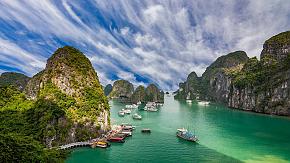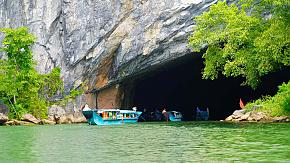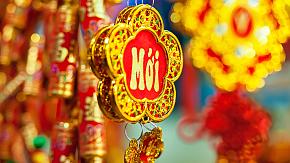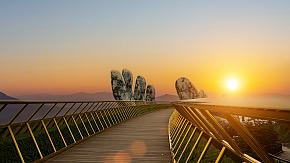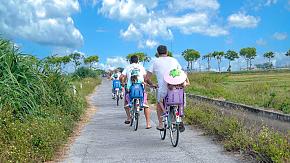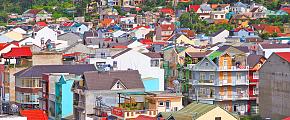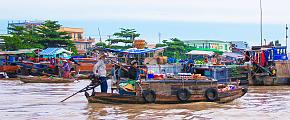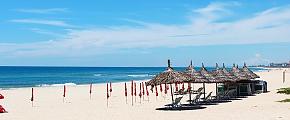Top 8 UNESCO World Heritage Sites in Vietnam
Vietnam is rich in natural scenery and human landscape due to its unique geographical advantages, attracting tens of thousands of tourists annually. Eight of the attractions have been designated as World Heritage Sites. If this is your first tour to Vietnam and are still determining where to begin your journey. Then these eight attractions will not disappoint you. Now, let's look at the allure these Eight attractions bring us.
Ha Long Bay
The 1,500 square kilometer estuary known as Ha Long Bay is home to thousands of large and small islands to the east of Hanoi. It was collected on the World Heritage List in 1994.
A sightseeing cruise ship will be an excellent choice if you wish to take in Ha Long Bay's numerous islands and distinctive peaks. Why is this situation so peculiar? The accumulation of time has created this outstanding seascape because the rocks above the sea surface are soluble boulders that have been long worn by the sea and washed away by the waves. The standing rock forest on the river has become a beautiful scenery and an important reason to attract many tourists.
In addition to Ha Long Bay, near the center of it, Bo Hon Island also features a nearly untouched tropical jungle. The island has beautiful vegetation and wild creatures like golden-haired monkeys freely there. The most fantastic highlight activity is seeing the numerous caves, such as Sung Sot Cave and Luon Cave. If you come to Ha Long Bay, you should go there to explore them. It is a lovely sightseeing spot with calm waves and distinctive peaks, creating a stunning scene that draws you to it.
 Halong Bay Cruise
Halong Bay Cruise
Hoi An Ancient Town
Vietnam's beauty extends beyond its natural beauty and historic sites. The Hoi An Ancient Town is located in Quang Nam Province, located 30 kilometers south of Da Nang, and will captivate you with its distinct charm.
Walking through the streets of the ancient town, you will be drawn to the ancient buildings on both sides with the local and foreign culture that is displayed everywhere. The ancient town was inscribed on the World Heritage List in 1999 for its distinct cultural charm. It was used as a trade port between Asian and European traders from the 15th to the 20th centuries. Under the influence of various cultures, traces of exotic customs have gradually spread throughout the ancient town.
Come to the ancient town; there are many attractions and activities to participate in, including the famous Japanese gallery bridge, which is a must-see for many photography enthusiasts. The covered bridge, built in the 16th century, is considered the classic traditional Oriental architecture. The entire covered bridge is made of wood and intricately carved.
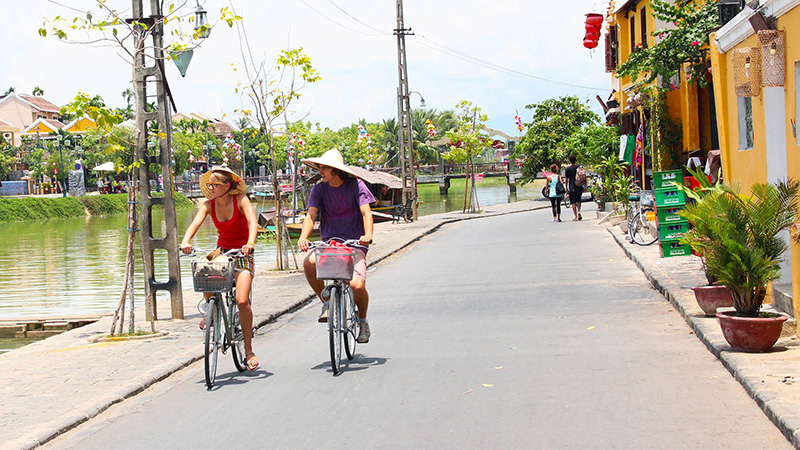 Cycle Around Hoi An Ancient Town
Cycle Around Hoi An Ancient Town
From a distance, it appears to be a rainbow. Furthermore, as you walk around town, you will notice numerous Assembly Hall, which were built by immigrant communities and are full of typical Oriental architectural designs, the most prominent of which is the Cantonese Assembly Hall, which is also a popular tourist attraction.
The beauty of the ancient town can only be appreciated in person. As a result, missing out on the ancient town of Hoi An will be a lifelong regret.
Complex of Hue Monuments
The Complex of Hue Monuments is situated in Hue, 654 kilometers from Hanoi, surrounded by the majestic Ngu Binh Mountain and the meandering Perfume River. It was added to the World Heritage List in 1993 due to its magnificent buildings and beautiful natural surroundings.
The Complex of Hue Monuments contains numerous points of interest. The Imperial City was built in 1805, and its architecture is similar to China's Forbidden City. The whole imperial City covers an area of 6 km2 and consists of four gates surrounded by a moat. The most famous structure within the Imperial City is the royal palace, which retains Vietnam's native architectural style, with exquisitely carved beams and columns stained with red lacquer, reflecting the dynasty's grandeur.
Keep walking, and you will reach the Forbidden Purple City, home to ancient emperors and their concubines. It reflects the emperor's lavish lifestyle at the time. The emperors were buried in the Hue Mausoleum when they died.
Each mausoleum has lovely landscape gardens, exquisite stone carvings, and a clear pond. With the quiet environment accompanied by birds singing and flowers, this area is also known as the emperor's back garden. If you haven't visited China's Forbidden City, the Complex of Hue Monuments is the ideal place to make amends.
 Odynovo Clients in the Imperial City of Hue
Odynovo Clients in the Imperial City of Hue
Phong Nha-Ke Bang National Park
If the Ha Long Bay and Bo Hon Island caves don't whet your appetite for adventure, Phong Nha-Ke Bang National Park in Quang Binh Province, 500 kilometers from Hanoi, will.
The Park's total area is approximately 200,000 hectares. There are over 300 large and small caves, surrounded by lush vegetation and massive rivers. The Park is the best example of how our planet has evolved. The 65 km of underground rivers and caves that stretch from a karst formation four billion years ago to the Laotian border demonstrate the Park's size.
A visit to the Park would be complete with exploring the various caves and the breathtaking views and stalactites. One of the most notable highlights is visiting the world-famous Phong Nha Cave and Paradise Cave. Phong Nha Cave is also named as the water cave because it conceals an underground river 1.4 kilometers away. The best way to experience this place is to take a boat ride into the cave. The Phong Nha Cave has 14 caves, each with colorful stone walls on both sides and exquisite stalactites against the stone walls.
There must be a dry cave with a water cave, and the dry cave here refers to the Paradise Cave. It is also known as Asia's largest dry cave. Unlike Phong Nha Cave, the inside of the Cave is explored by walking on wooden walkways. The area inside the cave is large, like a castle, and the stalactites in the cave are also set off by the more glorious light, as if indeed into 'heaven'.
My Son Sanctuary
My Son Sanctuary is another World Heritage Site located 40 kilometers west of Hoi An, unlike the classical architecture of Hoi An's ancient town. The My Son Sanctuary, also known as Vietnam's Angkor Wat, is the ancient Champa Kingdom's site, with pagoda temples made of red brick and sandstone.
The Cham began to build Hindu temples as early as the fourth century, and as their territory expanded, it eventually became the great Cham kingdom. The once glorious My Son Sanctuary was not demolished until the 13th century when the Cham Kingdom declined due to Nguyen's occupation.
Sanctuary's most notable feature is the exquisite stone carving technology. The stone carving paintings on the tower can be seen faintly, transporting you to the heyday of the Cham kingdom. The buildings are influenced by Southeast Asian and Indian cultures, and each has unique characteristics. However, affected by the Vietnam War, you can also see many relics of wars here. You can even see bullet holes or blown-up ruins on the walls, which is one of the main attractions for visitors.
Trang An Landscape Complex
If you've been to Ha Long Bay, the Trang An Landscape Complex is an additional natural paradise to compare. It is located in Ninh Binh Province and spans up to 4,000 hectares. It is famous for its unique karst valley, also called 'Ha Long Bay on land'.
The Landscape Complex contains several attractions, such as Relic Sites, Grottoes exploration, and etc. All of these are things you should value. Trang An was Vietnam's first capital, and Hoa Lu was the capital of the Ding and Li dynasties. There are now many relics, temples, and pagodas, the most famous of which is Bai Dinh Temple.
The magnificent Bai Dinh Temple is Southeast Asia's largest temple, and the golden plaques and unique architectural forms above the temple draw many tourists to stop and worship.
Furthermore, the most well-known scenic attraction is, of course, the karst caves. There are up to 48 large and small karst caves among the mountains. The longest is one kilometer long. The Cave's interior is one-of-a-kind, with stunning murals and various stalactites. A popular activity is exploring karst caves by taking a small boat. Trang An Landscape Complex was included in UNESCO in 2014 for its rich natural ecosystem and spectacular limestone landscape.
Imperial Citadel of Thang Long
The Imperial Citadel of Thang Long is located in the center of Hanoi. It was added to the World UNESCO Heritage List in 2010. It was constructed in the 11th century during Vietnam's Lee Dynasty and has grown from 2,000 square meters to around 20,000 square meters over the past 13 centuries.
The most prominent site, the Hanoi Flag Tower, is one of the most famous buildings to visit. The 41-meter-high Flag Tower, which serves as a landmark and the Imperial City's central axis, has witnessed the changes that have occurred throughout the Imperial City's history. The Imperial City is the next location you see by entering the Doan Mon Gate. According to legend, only members of the imperial house were permitted to enter through the Gate in ancient times. There are five arch entrances and exits on the Gate.
You can climb the stairs to the top of the Gate for a panoramic view of the Imperial City. The Kinh Thien Palace, located behind the Gate, was also used for imperial ceremonies and national celebrations. Imperial City has unique historical buildings and many excavated cultural relics, and people can't help but sigh at the prosperity of the Imperial City at the time; if you like architecture, don't miss this place.
Citadel of the Ho Dynasty
The Citadel of the Ho Dynasty is in Thanh Hoa Province's Vinh Loc district. It was inscribed on UNESCO's World Heritage list in 2011. It was established in the 14th century but only lasted seven years. The Citadel of the Ho Dynasty is distinct from other World Heritage Sites due to its rare stone wall architectural site and distinctive architectural characteristics. Its most distinguishing feature is the arched gates that greet you as you enter. It gives you a feeling of its glorious past.
Although the Citadel lacks the amenity of other World Heritage Sites, the surroundings will transport you to the countryside. Walking along the stone wall, you will realize that the surrounding golden rice fields make the Citadel more eye-catching, and the fresh and pleasant air makes you feel peaceful and quiet. If you like it, hurry up and come; I guarantee you will not come in vain.
Vietnam is a fantastic country with rich culture and many places of interest. The World Heritage sites are surprising with nature's superlative craftsmanship. From the Imperial Citadel of Thang Long to Ha Long Bay, each magnificent sites is full of flavor. If you are interested in them, please contact Odynovo as soon as possible. You can tell us your request, and our Vietnam specialists will customize your trip. Travel with Odynovo, and enjoy the best time in your life.
Quick Question
Related Posts You May Like
What Our Clients Say
Explore the latest verified reviews of Odynovo's travel services on Tripadvisor, Google, Trustpilot, Product Review and more trusted platforms.
SUBSCRIBE TO WIN A FREE TOUR
Subscribe to our newsletter for a chance to win a free 7-day tour to India! And more insider travel news, exclusive offers, and inspiration will be sent straight to your inbox. Check our previous newsletters and get some sparks.

